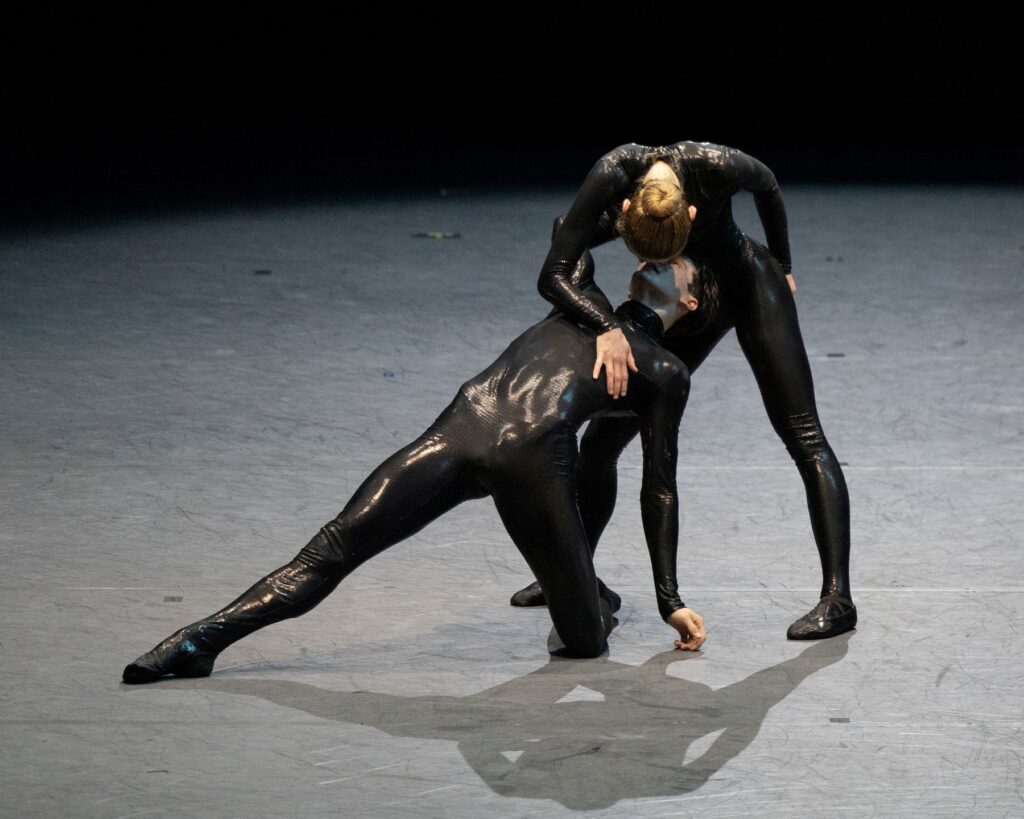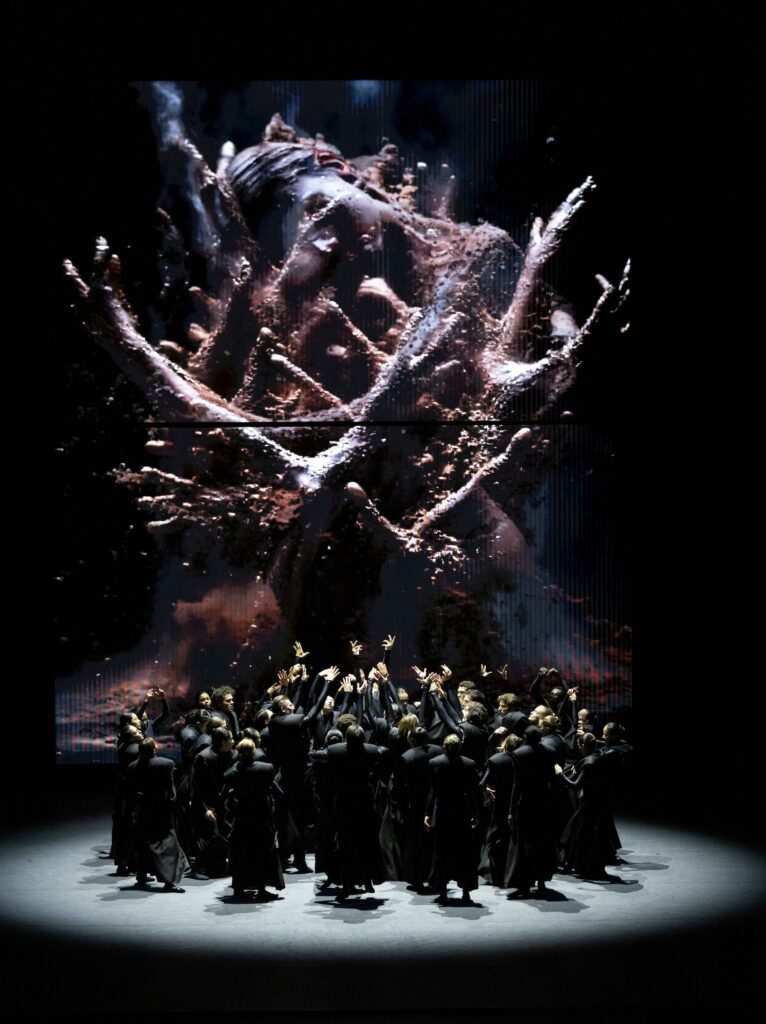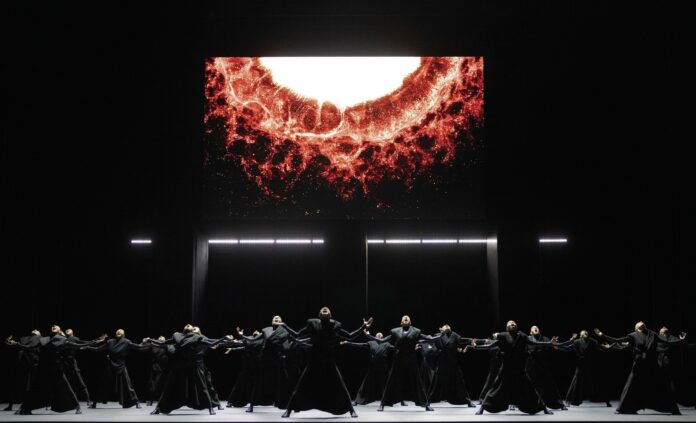We’re going double on Mere Mortals: Read 48 Hills stage critic Charles Lewis III’s review here.
In one fell swoop, choreographer Aszure Barton revealed what SF Ballet’s, and dance in general’s, history might have been like had it supported and nurtured more dances made by women—and also elevated more visionary artistic directors like Tamara Rojo, who replaced the legendary Helgi Tómasson last year as the first woman in that role at the institution. Mere Mortals (Through Thu/1 at the War Memorial Opera House, SF), astoundingly SFB’s first full-length commission by a woman, felt like the birth of something new. I honestly haven’t felt this purely exhilarated by a large-scale dance since I saw the company’s 2012 performance of George Balanchine’s Four Temperaments, and before that Merce Cunningham and company in Berkeley in 2008.
Cunningham had commissioned an electronic score for his chance-based Split Sides by Radiohead and Sigur Rós, and Four Temperaments paints an alien spell grounded in angular forms and Paul Hindemith’s heady 1943 composition. Now, Mere Mortals composer and electronic musician Floating Points brings full-on techno, a 40-year-old artform that dominates our culture, for heaven’s sake, into the War Memorial Opera House, with a fluid score full of gorgeous otherwordly sounds that combines sine-wave static and organic keening. (The Ballet orchestra performs brilliantly alongside its machine counterparts, including a Buchla synthesizer from 1963; Floating Points, aka the UK’s Sam Shepherd, is becoming one of the leading lights in hybrid orchestration.)

I start with the techno, native music of my Detroit peoples, because not only was the opening night studded with many of the city’s underground nightlife luminaries (there’s a party in the lobby after every performance with DJs Nooka Jones and Mozhgan playing deep cuts), but the crowd full of ballet regulars seemed genuinely into it.
SFB has worked with electronic scores before—recently, 2022’s “Blake Works 1” by William Forsyth with a melodic, house-y score by festival superstar James Blake, which I unfortunately missed due to COVID concerns. And I figured that the advanced sound design we encounter everyday on prestige TV shows and the random glitches of our Zoom calls and churning laptops have inured most to a little harsh noise and immersive klaxoning—tempered by one of the most beautiful violin solos I’ve heard in a while—should the occasion warrant. Still, I was taken aback at the rapturous reception. This could have been happening all along!
The occasion, of course, is the key. Rojo brought together Aszure, Floating Points, production designers Hamill Industries (who deployed flashing lights and large video screens on a stark stage), and costume designer Michelle Jank, giving them a general, very SF-relative prompt: How does the myth of Pandora’s Box apply to our contemporary feelings around Artificial Intelligence?
First, thank goddess the creators didn’t go the literal route and simply retell the story of Pandora with some rah-rah AI window dressing, like some late-night Tweeting tech VC who thinks he’s reinventing civilization. Instead, we are transported into a cosmic space where anxiety and hope are interwoven through the company’s eye-popping generative movements, which limn the language of classic ballet while morphing it into a plastic new utterance.
You get the creeping, hyper-multiplying shudders and dips into uncanny valleys you’ll recognize from viewing AI “art” online, although no AI was used directly in the piece—aside from some images tapped from a specially curated repository which, I assume, insures against the theft that threatens human artists with, at best, plagiarism, and, at worst, extinction. (There is in fact a wonderful joke in the piece when, writhing before a blossoming on-screen nebula of AI-generated hands, a mass of dancers raises their own, as if to say, We present you with your fatal weakness, oh great Wizard.) I didn’t see a list of artists whose original work was fed into the image bank, but I do hope they got paid.

Mere Mortal‘s narrative is blessedly ambiguous, but not open-ended: The ballet begins as it ends, although in a very different register, with the character of Hope (a sublimely inviting Wei Wang), floating on a sinuous, ever-recomposing cloud of bodysuited dancers. Hope is whisked away at the start, as what feels like a martial invasion fills the stage, gradually introducing characters distinguished by subtle personality traits despite their black, broad-shouldered uniforms. Pandora appears—Jennifer Stahl is spellbinding, eventually performing a rapturous solo and pas de deux with Parker Garrison (as Epimetheus) as part animated Francis Bacon painting, part malfunctioning swan, part molten dominatrix, part Foofwa d’Imobilité, all beauty and eroticism.
There is a terrific coup de ballet in a long scene where Stahl stands perfectly still in the shadow of a horizontal screen, as AI-like images of an evolving planet whiz by her, perhaps signifying our increasing powerlessness to stop the rapidly encroaching technology and/or transformation of Earth. Breathtaking moments—an extended back Cambré anchored with one foot in another dancer’s crotch, a sudden humping rhythm of the company against the floor, rapidly shifting character relationships, orgiastic agglomerations of limbs—spur semiotic reverberations: generative/ gender/ geneology/ geology/ generations…
Hey, why not gentrification, since our new AI overlords are still descending upon Hayes, er, Cerebral Valley. And maybe, even, some generosity? The reappearance of Hope wraps things up with a bit of clearcut positivity. Save us, Gen Z.
In a way, Mere Mortals does what the AI prophets dream their technology can achieve—birthing a new kind of art that transcends human imagination through the power of stable diffusion. (Keep that phrase in mind as you watch.) But, by creating something so wondrously corporeal and thought-provoking, we analogue humans are still having our own say in the matter.
SAN FRANCISCO BALLET: MERE MORTALS Through Thu/1 at the War Memorial Opera House, SF. More info here.





